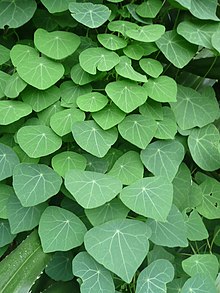
Back ستيفانيا (جنس من النباتات) ARZ Stefaniya Azerbaijani Stephania Bulgarian Stephania Catalan Stephania CEB Stephania (Gattung) German Stephania (planta) Spanish استفانیا Persian Stephania French Peleser ID
| Stephania | |
|---|---|

| |
| Stephania cephalantha | |
| Scientific classification | |
| Kingdom: | Plantae |
| Clade: | Tracheophytes |
| Clade: | Angiosperms |
| Clade: | Eudicots |
| Order: | Ranunculales |
| Family: | Menispermaceae |
| Subfamily: | Menispermoideae |
| Genus: | Stephania Lour. |
Stephania is a genus of flowering plants in the family Menispermaceae, native to eastern and southern Asia and Australia. They are herbaceous perennial vines, growing to around four metres tall, with a large tuber. The leaves are arranged spirally on the stem and are peltate, with the leaf petiole attached near the centre of the leaf. The name Stephania comes from the Greek, "a crown". This refers to the anthers being arranged in a crown-like manner.[1]
One species, S. tetrandra, is among the 50 fundamental herbs used in traditional Chinese medicine, where it is called han fang ji (漢防己, "Chinese fang ji"). Other plants named fang ji are sometimes substituted for it. Other varieties substituted include Cocculus thunbergii, C. trulobus, Aristolochia fangchi, Stephania tetrandria, and Sinomenium acutum. Notable among these is guang fang ji (廣防己, "(GuangDong, GuangXi) fang ji", Aristolochia fangchi. Because of its toxicity, it is used in TCM only with great caution.
- ^ Les Robinson (2003). Field Guide to the Native Plants of Sydney. Kangaroo Press. p. 336. ISBN 978-0-7318-1211-0.